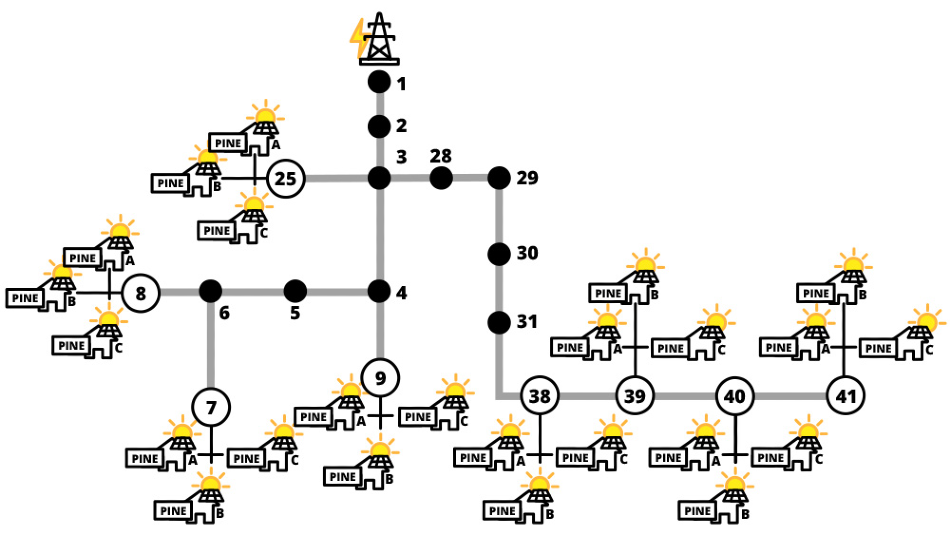Jul 24 2020
A smart technology designed by scientists from Texas A&M University and industry can allow utility companies to serve communities impacted by blackouts in a better way.
 Mixed neighborhood used in the researchers’ computer simulation. Open circles denote nodes where homes have PINE systems and dark, filled circles are nodes where homes do not have PINE. All homes receive energy from the grid. Image Credit: Rachel Barton/Texas A&M Engineering.
Mixed neighborhood used in the researchers’ computer simulation. Open circles denote nodes where homes have PINE systems and dark, filled circles are nodes where homes do not have PINE. All homes receive energy from the grid. Image Credit: Rachel Barton/Texas A&M Engineering.
According to scientists, the single device operates by enhancing energy supply between the electrical grid and home solar-power systems.
Our innovation lets solar energy consumers be less dependent on the external power grid. The same technology also allows the utility company to control energy distribution, which is particularly useful during power outages caused by storms and other natural disasters. So, It’s a win-win scenario for both the consumer and the utility company.
Dr Le Xie, Professor, Department of Electrical and Computer Engineering, Texas A&M University
The new study appeared online in the Institute of Electrical and Electronics Engineers’ Journal of Emerging and Selected Topics in Power Electronics in April 2020.
The cost of solar panels has dropped considerably in the last 10 years, which motivated more homes to install solar power systems. In such households, the power produced by rooftop solar panels is delivered to an inverter before the electricity is set for charging solar backup batteries and for residential use.
The batteries and solar panels are connected back to the grid through another set of power electronics. With such connections, homes are invariably linked to the grid, provided the grid is operational.
During daytime, households use up more solar energy, and surplus energy, if left, is supplied to the grid. During nighttime, homes use up the electricity from the grid.
But the scientists observed that such traditional systems have several drawbacks. For example, if there were voltage fluctuations in the grid—caused by overloading or damage to the power lines—they would impact the connected devices in households.
The researchers also informed that the current fed into the grid from solar-powered homes can have specific irregularities called harmonics, impacting the power quality inside the grid.
Another relevant issue highlighted by the scientists is that utility companies cannot do much to restrict the proportion of grid electricity used up by solar-powered homes. This disadvantage is specifically dangerous at the time of natural disasters where essential services, such as hospitals, and other communities require energy support.
Currently, there’s no system in place to regulate or limit energy consumption. End users with solar-powered systems continue drawing electricity from the grid because utility companies have no way of controlling it.
Dr Prasad Enjeti, TI Professor III, Analog Engineering, Department of Electrical and Computer Engineering, Texas A&M University
In contrast to the traditional solar-powered systems in which several electronics are linked to and forth from the grid, the scientists assembled a single device, known as the power electronics intelligence at the network edge, or PINE for short.
Installed outside a home, this device contains three primary connections: one to the utility grid, the second to the home, and the third to the batteries and solar panels. PINE can regulate the flow of current in any one of these directions.
Enjeti added, “This device is like an intelligent energy router. It regulates the grid voltage, integrates solar energy, which is locally produced, and intelligently manages and routes the energy in all directions.”
The scientists have also developed this device to be programmable, so that an accredited external user, such as the utility company, can regulate the amount of grid electricity that reaches the solar-powered homes.
According to Enjeti, PINE systems deployed at various homes can even be programmed to interact with the distribution operator and with one another.
To verify if the PINE networks work as visualized, the scientists constructed a hardware prototype and performed elaborate computer simulations of a mixed neighborhood where a few households had the PINE systems, while others did not.
The combination of simulations and hardware performance showed that households with the PINE system had a stable and cleaner voltage. At the grid level, the injected voltage from these households was also observed to be stable since the PINE system was controlling that as well.
PINE systems can dynamically and in real-time inject different voltage support to the utility grid. So, the utility companies need not spend millions in buying capacitor banks to support the voltage across the feeder lines.
Dr Le Xie, Professor, Department of Electrical and Computer Engineering, Texas A&M University
Xie continued, “During power outages, PINE allows homes to be self-sufficient and use their solar power efficiently. The technology also allows the utility company to wirelessly instruct PINE systems to limit the grid current to solar-powered homes and redirect it to other affected areas.”
The PINE technology was jointly developed by Enjeti, Xie, and Dr P. R. Kumar, Regents Professor and Distinguished Professor in the department of electrical and computer engineering and the College of Engineering Chair in Computer Engineering.
Others who contributed to this study include Jorge Ramos-Ruiz from the Department of Computer Science and Engineering, Dr Bin Wang from the National Renewable Energy Laboratory, and Dr Hung-Ming Chou from Dominion Energy.
This study was financially supported by Consejo Nacional de Ciencia y Tecnologia, the United States Department of Energy, and the National Science Foundation.
Journal Reference:
Ramos-Ruiz, J., et al. (2020) Power Electronics Intelligence at the Network Edge (PINE) – An Approach to Interface PV and Battery Energy Storage Systems at the Grid Edge. IEEE Journal of Emerging and Selected Topics in Power Electronics. doi.org/10.1109/JESTPE.2020.2991019.